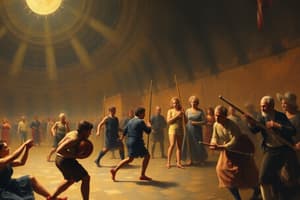Podcast
Questions and Answers
How did the introduction of iron technology primarily contribute to the development of classical civilizations?
How did the introduction of iron technology primarily contribute to the development of classical civilizations?
- By enabling the construction of more elaborate religious structures.
- By fostering greater cultural homogeneity across different regions.
- By facilitating more efficient agricultural practices and military capabilities. (correct)
- By promoting a shift towards more egalitarian social structures.
Which factor most significantly contributed to increased social mobility during the era of classical civilizations?
Which factor most significantly contributed to increased social mobility during the era of classical civilizations?
- The diminished importance of religious institutions in daily life.
- The widespread adoption of democratic governance structures.
- The expansion of opportunities through military service, commerce, and education. (correct)
- The breakdown of traditional family structures.
Which of the following accurately describes the role of trade routes like the Silk Road and Mediterranean networks during the Classical Civilization period?
Which of the following accurately describes the role of trade routes like the Silk Road and Mediterranean networks during the Classical Civilization period?
- They acted as conduits for the spread of goods, ideas, and technologies across diverse regions. (correct)
- They primarily facilitated the exchange of luxury goods among the elite classes.
- They primarily served to reinforce existing political boundaries and limit cultural exchange.
- They had a minimal impact on the economic and cultural development of participating societies.
What was a significant consequence of the expansion of empires like those of Greece, Rome, Persia, and China during the Classical Civilization period?
What was a significant consequence of the expansion of empires like those of Greece, Rome, Persia, and China during the Classical Civilization period?
How did advancements in agriculture, metallurgy, and political organization collectively influence societal structures during the Classical Civilization period?
How did advancements in agriculture, metallurgy, and political organization collectively influence societal structures during the Classical Civilization period?
Which of the following best describes a significant change that occurred during the Neolithic period?
Which of the following best describes a significant change that occurred during the Neolithic period?
In what way did the development of agriculture during the Neolithic period impact social structures?
In what way did the development of agriculture during the Neolithic period impact social structures?
Which of the following technological advancements is most closely associated with the Early Civilization (Bronze Age)?
Which of the following technological advancements is most closely associated with the Early Civilization (Bronze Age)?
Which of the following best describes the role of religion in Early Civilizations (Bronze Age)?
Which of the following best describes the role of religion in Early Civilizations (Bronze Age)?
How did trade networks evolve and expand during the Early Civilization (Bronze Age)?
How did trade networks evolve and expand during the Early Civilization (Bronze Age)?
Which of the following characterizes social stratification in Early Civilizations (Bronze Age)?
Which of the following characterizes social stratification in Early Civilizations (Bronze Age)?
What was a key characteristic of human societies during the Paleolithic era?
What was a key characteristic of human societies during the Paleolithic era?
Which development during the Paleolithic era demonstrates cognitive and cultural advancements?
Which development during the Paleolithic era demonstrates cognitive and cultural advancements?
Flashcards
Classical Civilization Period
Classical Civilization Period
Period from 1200 BCE to 500 CE marked by empires, philosophy, and trade.
Impact of Iron Technology
Impact of Iron Technology
Enhanced warfare and agriculture in the Classical Age.
Administrative and Legal Systems
Administrative and Legal Systems
Complex systems, laws, and structures implemented by empires like Greece and Rome.
Silk Road and Mediterranean Networks
Silk Road and Mediterranean Networks
Signup and view all the flashcards
Transformation of Societies
Transformation of Societies
Signup and view all the flashcards
Societal Evolution
Societal Evolution
Signup and view all the flashcards
Paleolithic Era
Paleolithic Era
Signup and view all the flashcards
Hunter-Gatherers
Hunter-Gatherers
Signup and view all the flashcards
Discovery of Fire
Discovery of Fire
Signup and view all the flashcards
Neolithic Period
Neolithic Period
Signup and view all the flashcards
Agriculture and Pastoralism
Agriculture and Pastoralism
Signup and view all the flashcards
Bronze Age
Bronze Age
Signup and view all the flashcards
Early Civilizations
Early Civilizations
Signup and view all the flashcards
Study Notes
- Human societies have evolved throughout history in response to environmental, technological, and social changes.
- Societies transitioned from the Paleolithic era, to the Neolithic, Early Civilization (Bronze Age), and Classical Civilization (Iron Age) periods.
- Each era reshaped how people lived, worked, and interacted.
- There were transformations in environments, technologies, cultures, political systems, social structures, and economies.
- The shift from small nomadic groups to complex urban societies marked a significant change.
- Some continuities persisted across these periods, like the management of resources and social hierarchies remained important.
Paleolithic Era
- This era was from approximately 2.5 million–10,000 BCE
- Humans lived as hunter-gatherers and depended on the environment for survival.
- People were highly mobile, adapting to climates and landscapes as small bands migrating for food.
- The discovery of fire, rudimentary tool development, and early artistic and religious expressions signified cognitive and cultural advancements.
- Societies remained relatively egalitarian because resources were shared.
Neolithic Period
- This era was from approximately 10,000–3,000 BCE
- Humans domesticated plants and animals which led to permanent settlements and population increase.
- Agriculture and pastoralism allowed for food surpluses, fostering specialization, trade, and more hierarchical social structures.
- Villages and early towns emerged, with spiritual practices tied to fertility and nature.
Early Civilization Period (Bronze Age)
- This era was from approximately 3,000–1,200 BCE
- Cities, centralized governments, and writing systems arose.
- Large-scale irrigation agriculture supported dense populations in river valley civilizations
- Political power became concentrated in rulers and priestly elites
- Religion often legitimizing authority
- Bronze tools and weapons facilitated military expansion and infrastructure projects.
- Trade networks expanded across regions; connecting societies through the exchange of goods like metals, textiles, and luxury items.
- Social stratification became more pronounced, with clear distinctions between rulers, priests, merchants, artisans, and laborers.
Classical Civilization Period (Iron Age)
- This era as from approximately 1,200 BCE–500 CE
- Vast empires, advanced philosophical and legal systems, and interconnected trade networks emerged.
- Iron technology revolutionized warfare and agriculture, enabling larger and more efficient armies and farming techniques.
- Empires, such as those of Greece, Rome, Persia, and China, introduced complex administrative systems, legal codes, and civic structures.
- Cultural and religious diversity increased with the rise of major world religions.
- Trade routes facilitated the exchange of goods, ideas, and technologies on an unprecedented scale.
- Social hierarchies remained rigid, but new opportunities arose for mobility through military service, commerce, and education.
- Societies transformed from small, egalitarian bands to stratified and complex civilizations because of advancements in agriculture, metallurgy, and political organization.
- Environmental factors, technological innovations, and interactions between societies drove these changes, shaping human history.
- Each era had unique characteristics, the overall trajectory shifted toward larger, more interconnected, and structured societies.
- These eras laid the foundation for the modern world.
Studying That Suits You
Use AI to generate personalized quizzes and flashcards to suit your learning preferences.




